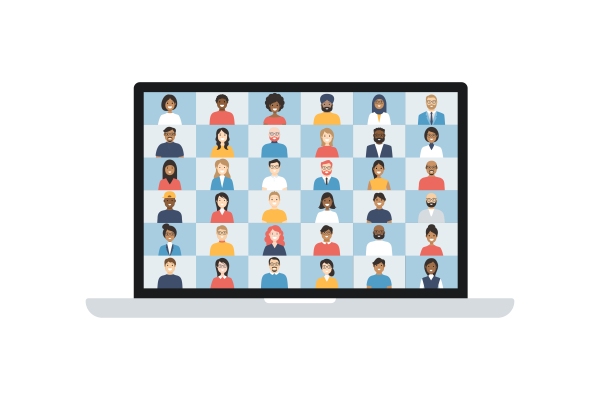Systemic racism is nothing new in America, and the effects of unconscious racial bias have long created inequity in the workplace. So why — when presented with the task of developing new “normal” hybrid workplaces — are we allowing the same systemic problems that boxed generations of Black and brown people out of the workforce to exist?
We must bravely confront this problem with whatever tools are available to us now while we still have a once-in-a-generation chance to shape the foundation of what is being built.
Statistics help tell the story of stark disparities in the economic status of Black and white families. The typical Black household earns only 57 cents on the dollar made by white families, and the median wealth of Black families is just $17,000 — compared with $171,000 for white families. Black families also suffer from lower annual incomes, making about $29,000 less a year, on average, than their white counterparts. Their children are three times as likely to grow up in poverty and stay poor throughout their lifetimes. There’s also a dismal wealth gap in homeownership: Only 42% of Black families own their homes, compared with 73% of white families.
I recently shared this data with lawmakers serving on the U.S. House Financial Services Committee’s Subcommittee on Diversity and Inclusion. The hearing, “The Legacy of George Floyd: An Examination of Financial Services Commitments to Economic and Racial Justice,” specifically addressed the negative economic impact of systemic racism in the financial services industry. Everything from biased lending practices to an imbalance in the distribution of philanthropic dollars has massive economic ramifications.
Equity cannot be fully achieved by simply donating money to external partners, such as my organization, the National Urban League. While I’m the first to say the league and many of my colleagues in the field are doing great work, too many companies are relying on us alone to change the world.
Actions speak. Entrepreneurs need to help get their employees into proven training programs that show the true impact of their unconscious biases. Startups must look inward and ensure their organizations are diverse, inclusive and equitable places for both employees and their customers.
But this requires internal work. And in certain cases, external voices. We have already seen companies like Comcast NBCUniversal, Charter Communications and T-Mobile create external diversity and inclusion councils with independent leaders to advise and help drive common objectives forward.
Promoting diversity, equity and inclusion (DEI) isn’t just the right and moral thing for entrepreneurs to do. It also makes economic sense. Companies that stress internal diversity are more profitable, as they can successfully appeal to more diverse markets. Ethnically diverse companies are 35% more likely to outperform companies with less diversity.
To be sure, the COVID-19 pandemic disrupted and profoundly altered many aspects of work life, including in-person diversity training and workforce development.
As more workplaces move to a hybrid model of remote and in-person work, this is the time to take DEI off the back burner and rethink inclusion programs to incorporate leading-edge technology to reach employees wherever they are.
Companies must start now. But there’s no need to start from scratch. The resources already exist, and there is a wealth of external partners that can help improve corporate culture and diversity metrics. With a deep and nuanced understanding of the issues at hand, civil rights organizations are uniquely poised to support corporate DEI management by providing strategic advisory services, executive coaching, DEI subject matter expertise, and DEI strategy development and planning. For instance, we have the lessons we’ve learned over our 111 years working to connect diverse communities to opportunities, and we integrate these lessons with new tech advancements to advise our partners.
Accordingly, groups like the National Urban League have successfully collaborated with public and private partners on the issues of diversity, inclusion, fair employment, equity and parity. Although these conversations can sometimes be difficult, companies who are intentional in addressing these issues must do so head-on.
Here are some ways founders can usher in a more inclusive startup culture in a hybrid work environment.
VR training programs
Virtual reality technology is one of the newest additions to the DEI training toolbox to facilitate having those sometimes difficult discussions. Virtual reality scenarios can be used to train a large group of people in a cost-effective way.
By donning a VR headset, individuals can participate in an immersive training experience where they can engage in a conversation about race and inherent bias without fear of judgment or reprisals.
For example, Moth+Flame, a Brooklyn-based virtual reality developer and production studio, has already developed successful DEI programs for the U.S. Air Force and Accenture, where users enter a simulated real-world environment to practice tough conversations using their own voice. This innovative technology offers a deep level of immersion that creates a long-lasting emotional impact for employees.
The beauty of VR is that it lends itself well to in-person situations and can also be used effectively with remote employees. In a hybrid workplace, VR ensures all employees walk away with a consistent training experience — regardless of their location.
Professional and workforce development programs
Programs can be developed for America’s startups to connect recruiting teams to historically Black colleges and universities and other minority-serving institutions. These programs include supported and hosted online job boards, career fairs and workforce development initiatives.
But just getting diverse faces in the door isn’t enough — that’s only diversity. Founders need to invest in their employees of color by allowing them to participate in professional development programs to create the next generation of executives — that’s equity. This is even more critical with a dispersed workforce as a divide in the employee experience can become more pronounced when some groups work in the office and some remain remote. Workers can feel left out, lonely or just out of the loop. Professional development programs encourage employee engagement and signal the company is investing in their personal and professional growth despite where they are located — that’s inclusion.
Supplier diversity
The return to some level of in-office activities also comes with the return of relying on suppliers — like travel agents, catering vendors, event production companies and more. As companies look for new suppliers to build out their new hybrid work environments, they should be working now to create a framework for establishing a diverse supplier network, vetting current vendors and sourcing new vendors.
Based on my experience, many companies consistently list difficulty in locating diverse suppliers as the chief impediment to furthering such diversity. To remedy the problem, BidConnect USA created a centralized business network platform that connects companies and government agencies with small businesses, aggregates online events and creates a tool to foster ethical practices and economic inclusion.
Recognizing, assessing, measuring
Without employees coming together in the same office day in and day out, it can be harder for staff to feel when progress is made toward positive company cultural change. That’s where numbers and accountability come into play.
Startups must transparently determine which metrics they want to incorporate to measure diversity within their organization. With equity being a higher priority than ever for employees, consumers, investors and activists, there have never been greater risks and costs for lagging or greater rewards and benefits for leading.
Management Leadership for Tomorrow’s (MLT) Black Equity at Work Certification Program enables employers that embrace rigorous action to minimize downside and maximize upside by assuring major, sustained Black equity progress and providing valuable recognition.
The MLT program isn’t another pledge, index or disclosure push. It’s a unique, affordably priced improvement system that includes a meticulously developed scoring rubric that quantifies overall Black equity progress; planning resources and support that enable employers to chart their own path on their timeline; an array of valuable services that ensure and accelerate results; and a high degree of trust and guarantee of strict confidentiality. Socializing tangible data to measure progress toward diversity goes a long way toward shaping company culture.
Achieving full racial equity and inclusion won’t be easy. It requires the firm commitment of all sectors of our civil society. Government entities, startups, private and public companies, and nonprofits alike need to ask themselves uncomfortable questions, address inequities head-on, and resolve to change practices and policies so that all people have equal opportunities to live full and prosperous lives. With the right programs in the hands of dedicated employees, we might just get there a little faster.


